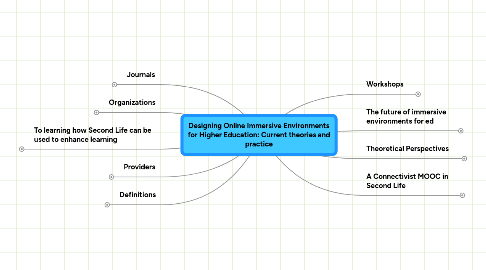
1. Workshops
1.1. Introductory
1.1.1. Learning in a connectivist mode
1.1.1.1. Three principles
1.1.1.1.1. Usability
1.1.1.1.2. Relevance
1.1.1.1.3. Interaction
1.1.1.2. New node
1.1.2. The avatar
1.1.2.1. Hero
1.1.2.2. approximation of real world self
1.1.2.3. alternative view of self
1.1.2.4. alternative to human forms
1.1.2.5. Change your real-life appearance
1.1.2.5.1. We are already cyborgs
1.1.3. The application and account
1.1.4. Navigation
1.2. Building and Scripting
1.2.1. Language Interpreters in SL
1.2.2. Espanol
1.2.3. Tutorials
1.3. Planning a build
1.3.1. Open Grid
1.3.2. Education collective
1.3.3. Private Island
2. Journals
2.1. Journal for Virtual Worlds and Education.
3. Organizations
3.1. Center for Virtual Worlds Education and Research
3.2. MediaGrid - Immersive Education Technology Group (IETG)
4. To learning how Second Life can be used to enhance learning
4.1. Functional
4.1.1. Research
4.1.1.1. Real world research about immersive environments
4.1.1.2. Research in virtual worlds about RL issues
4.1.1.3. Using online collaborative games to solve scientific problems.
4.1.1.3.1. Foldit
4.1.1.3.2. EteRNA
4.1.1.3.3. GalaxyZoo
4.1.1.4. games to solve social problems
4.1.1.4.1. Free Rice
4.1.1.4.2. The Extraordinaries
4.1.1.4.3. EVOKE
4.1.1.5. MIT Center for Collective Intellignece
4.1.1.5.1. Call for more research
4.1.2. Administrative
4.1.2.1. Student services
4.1.2.1.1. Orientation
4.1.2.1.2. Foreign student acculturation
4.1.2.2. Meetings
4.1.3. Teacher prep simulations
4.1.4. PLE
4.2. Soft skills
4.2.1. Social
4.2.1.1. Recreational
4.2.1.1.1. Teledildonics
4.2.1.2. Campus LGBT
4.2.1.3. Critical Pedagogy
4.2.1.4. Social Good
4.2.1.4.1. Social marketing
4.2.1.4.2. Advocacy
4.2.2. Teaching
4.2.2.1. Topics
4.2.2.1.1. About RL issues
4.2.2.1.2. About VR
4.2.2.2. Types
4.2.2.2.1. Stand and deliver
4.2.2.2.2. Blended
4.2.2.2.3. CSCL
4.2.2.2.4. Presence Pedagogy
4.2.2.3. Presence in small group discussions
4.2.2.3.1. e.g MOOC breakout @ Conviviality Corners
4.2.2.3.2. Skupik "something powerful about sitting around a fire"
4.2.2.3.3. Empowered by the ability to chose to be there
4.2.3. Therapeutic
4.2.3.1. Psychotherapy
4.2.3.2. Group therapy
4.3. Hard Skills
4.3.1. Engineering
4.3.2. Computer Science
4.3.3. VR Technology
4.3.3.1. Haptic Technology
4.3.4. Commerce
4.3.4.1. Linden Dollars
5. Providers
5.1. Second Life
5.1.1. Successful $100M/year
5.1.2. Conviviality Corners
5.1.3. Many education institutions have spaces
5.2. Virtual Academy
5.2.1. Exclusively education
5.2.2. reconstructs classroom learning in virtual spaces
6. The future of immersive environments for ed
6.1. Impact of augmented reality?
6.1.1. Rendering objects into pics
6.1.1.1. What is reality anyway?
6.1.1.1.1. Holograms
6.1.1.2. Layar
6.1.1.3. Auto repair
6.1.2. Believing is seeing
6.1.3. Natural User interface
6.1.3.1. Kinnect
6.1.3.1.1. Game play
6.1.3.1.2. Retail shopping
6.1.3.1.3. Medical
6.1.3.1.4. Kinnect to animate avatars
6.2. The Matrix
6.3. Ubiquitous computing
6.4. the internet of things
7. Theoretical Perspectives
7.1. Socio-technology
7.1.1. Technological determinism
7.1.1.1. Science Finds – Industry Applies – Man Conforms
7.1.1.2. technology as politically and ethically neutral
7.1.2. Diffusion of Innovations
7.1.2.1. early adopters
7.1.2.2. Ceiling or saturation point
7.1.2.3. adoption threshold
7.1.2.4. critical mass
7.1.2.5. New node
7.1.3. Social shaping of technology
7.1.3.1. importance of human choices and action in technological change
7.1.3.2. actor-network theory
7.2. Emerging theories
7.2.1. Grounded Theory
7.2.1.1. Existing theory inadequate
7.2.1.2. a theory about patterns of behavior exhibited by people as they resolve their central concerns.
7.2.1.3. Rapid development/emergence
7.3. Pedagogy
7.3.1. Junior education K-12
7.3.1.1. socialization
7.3.1.1.1. Age limitations - 4 yr old on Daddy's lap - in SL with Grandpa - on beyond Skype
7.3.1.2. demonstrations/models
7.3.1.2.1. science math geography
7.3.2. VocTech
7.3.2.1. Professional Skills based
7.3.2.1.1. Health related
7.3.2.1.2. Disaster management
7.3.2.1.3. civil engineering
7.3.2.1.4. construction
7.3.2.1.5. Situated learning in communities of practice
7.3.3. Higher Ed
7.3.3.1. Arts and Sciences
7.3.3.2. Liberal arts
7.3.3.3. Visual/plastic arts
7.3.3.4. Performing arts
7.4. Cybergogy
7.4.1. and Social constructionism, Scopes 2009
7.5. Game Theory
7.5.1. Gee
7.5.2. Quest to Learn
7.6. Androgogy
7.7. Heutagogy
7.8. Critical pedagogy
7.8.1. decolonialization
7.8.2. CAGE
7.8.3. Whiteness studies
7.9. Deci, Self determination theory Learner Hero
7.9.1. individual personal autonomy
7.9.2. collaborative or team goals
7.10. Motivation theory
7.10.1. Autonomy
7.10.2. Flow
7.11. Computer supported Collaborative Learning
7.12. Connectivism
7.12.1. MOOCs
7.12.1.1. SL Cohorts
7.13. Social Learning theory
7.14. Collective Intelligence
7.14.1. At MIT Center for Collective Intelligence
7.15. Network theory
7.15.1. Four Loci of network power
7.15.1.1. Power of inclusion in a network
7.15.1.2. Gatekeeping
7.15.1.3. New node
8. Definitions
8.1. Virtual worlds
8.1.1. digital environment that is a representation of a real or imaginary geographic place.
8.1.2. the requirement that a user adopt a character, avatar, or personality that resides within that world and is the means by which the user interacts.
8.1.3. shared or multi-user, persistent virtual environments that are simulated/implemented by a computer (or a network of computers)"
8.1.4. Metaverse=emerging concept that describes the combining of the web, virtual reality and augmented reality
9. A Connectivist MOOC in Second Life
9.1. Concept
9.1.1. Use SL to organize a group of people interested in learning theory.
9.1.1.1. Rather than using a LMS use Sl
9.1.1.2. Participants could still develop their own PLE and display/share/ in SL
9.1.2. Use Boitshwarelo's framework to organize part of the research effort.
9.2. Purpose
9.2.1. To contribute to the body of theoretical knowledge about teaching and learning
9.2.2. To test available theories particularly connectivitsm
9.2.3. To set the ground for further theory development
9.3. Problem
9.3.1. Emerging online technology is having a profound effect on educational practice.
9.3.2. Traditional theories of teaching and learning are not adequate.
9.3.3. People and institutions are looking for new approaches and new modalities but need them to be based on sound theroetical footings supported by peer-reviewed research.
9.3.3.1. Early MOOCs were constructivist but the process has been co-opted by institutions and high profile academics. xMOOCs are more prescriptive than emergent.
9.4. Research Methodology
9.4.1. Boitshwarelo Integrated research framework for connectivism
9.4.1.1. "Online communities of practice are manifestations of connectivism"
9.4.1.2. Previous studies of two types
9.4.1.2.1. Case studies focusing on existing social networks that already have well defined histories, norms, identities
9.4.1.2.2. Case studies of attempts to build infrastructure of online communities within a given educational setting.
9.4.1.3. Design-based research
9.4.1.3.1. Iterative design interventions characteristic of technology based learning environments.
9.4.1.4. Assumptions of Activity Theory
9.4.1.4.1. Unity of Consciousness and Activty
9.4.1.4.2. Intentionality
9.4.1.4.3. Contradictions
9.4.1.4.4. Mediated Action
9.4.1.4.5. Historicity
